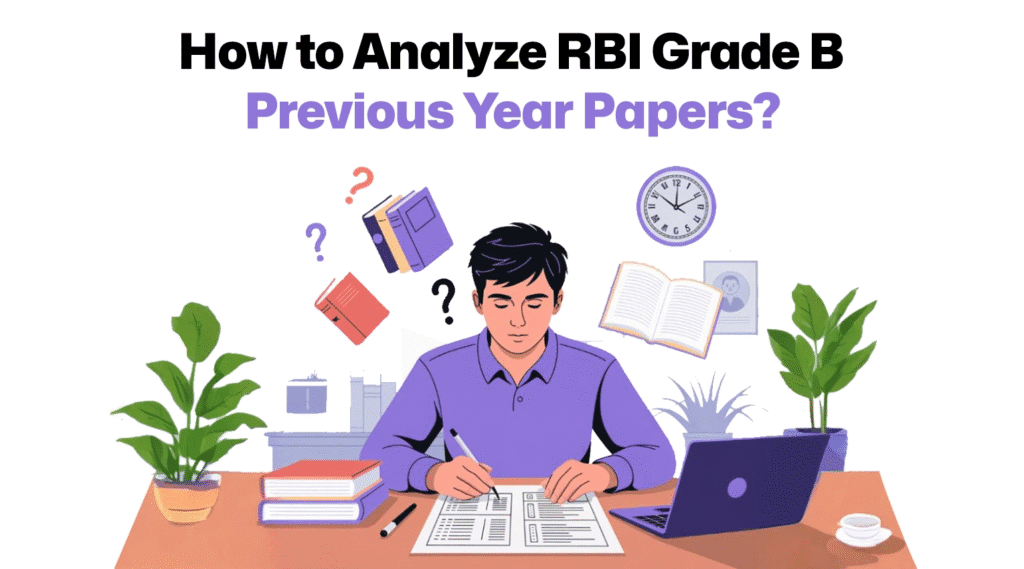Whether you are beginning your RBI Grade B preparation, or you are in the middle of it, or you are all done with the preparations, and just want to revise consistently, you will need the RBI Grade B previous year question paper at each stage of your preparation journey.
These previous year question papers are not some practice sets; these are the most powerful practice resource you can use to prepare for the exam. Analyzing and solving the RBI Grade B previous year question paper continuously and consistently, that’s where the real magic happens.
Every one of you should start here and end here as well, because you will understand that by analyzing the previous year’s question papers, you are understanding the actual needs of the syllabus, scope of preparation, tough and easy questions, and so much more for the RBI Grade B exam.
In this article, we’ll break down exactly how you can analyze past papers and use them to shape your preparation.
What You Learn from Previous Year Papers
When you analyze the RBI Grade B previous year papers the right way, you start to understand the exam from the inside. You’ll notice three important things:
- How the questions are framed: Some questions look simple but are actually tricky. You’ll see how RBI tests your concept clarity, especially in reasoning and finance.
- Topic trends: Certain topics like Monetary Policy, Banking System, or Decision Making in Management appear regularly. Others may come once in 5 years. Knowing this helps you prioritize.
- Time management pattern: You’ll get an idea of how long each section actually takes. Phase 1, for example, looks doable until you try solving it under time pressure.

How to Analyze the Papers Like a Topper
Solving is step one. Analyzing is step two.
- After attempting a paper, go back and review each question. Ask why a particular option was right, not just which one.
- Highlight topics that keep repeating. If the RBI Grade B asks questions on Financial Inclusion or Leadership every year, that’s your green signal to master it.
- Track sectional balance. For example, in RBI Grade B Phase 1, is the reasoning always longer? Is English passage-heavy or grammar-focused?
- For descriptive answers in RBI Grade B Phase 2, compare your answers with the model structure. Focus on how the points are organized and how language is kept formal and clear.
This is exactly what toppers do: they don’t just solve papers, they break them down like examiners.
How to Use Analysis to Restructure Your Prep
Once you have insights from the previous year papers, the next step is to apply them.
Let’s say Finance questions often come from 7 core areas, now your preparation doesn’t need to cover 25 random chapters. Focus on the high-return ones.
In General Awareness, you’ll notice a pattern of scheme-based, ranking-based, and budget-related questions. That means your current affairs prep must be targeted, not broad.
For English descriptive, past essays and precis topics help you see how RBI Grade B prefers clear, balanced opinions. Use this to build your writing style.
Overall, your study plan becomes leaner, focused, and based on data, not just advice from toppers or coaching.
Mistakes Students Make While Using Previous Year Papers
Not all use these papers wisely. Here are common mistakes:
- Treating it like just another mock test. Solving without reviewing defeats the whole point.
- Ignoring descriptive trends. Just because it’s not MCQ doesn’t mean it can’t be predicted. Paper 2 and Paper 3 topics follow themes: economics, governance, ethics.
- Skipping analysis of wrong answers. Don’t move on after checking marks. Understand why you got something wrong, concept gap, silly mistake, or lack of revision?
Another mistake? Using unofficial sources. Always solve official RBI papers, not those “based on memory” ones that circulate online without verification.
Final Tips Before You Begin Analysis
Before you dive in, here are a few things to keep in mind:
- Where to get papers: Download the official RBI Grade B previous year question papers from the RBI website or reputed sources you can find online.
- How many years to analyze: At least the last 5 years for Phase 1 and Phase 2. Go deeper (up to 10 years) for descriptive topics and trends.
- When to start: Begin analyzing right after understanding the syllabus. Use the insights to build your study timetable, not the other way around.
Analysis works best when done early in your preparation. Don’t wait till your syllabus is “complete.”
Conclusion
Treat the RBI Grade B previous year question paper as a guidebook, not just a set of practice questions. If you analyze it properly, it shows you what to expect, what to avoid, and what to focus on.
It saves you time, helps you revise smarter, and gives you a clear picture of where you stand. The exam isn’t just about hard work, it’s about smart work. And analyzing past papers is one of the smartest moves you can make.
Let the previous papers show you the way, and you’ll walk into the exam hall with far more confidence and clarity than most.
Add Business Connect magazine to your Google News feed



